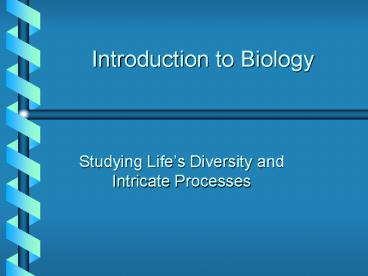Introduction to Biology - PowerPoint PPT Presentation
1 / 29
Title:
Introduction to Biology
Description:
Introduction to Biology. Studying Life's Diversity and Intricate Processes. Biological Inquiry ... Living things respond to stimuli from their environment. ... – PowerPoint PPT presentation
Number of Views:84
Avg rating:3.0/5.0
Title: Introduction to Biology
1
Introduction to Biology
- Studying Lifes Diversity and Intricate Processes
2
Biological Inquiry
- Bio of living things
- What Are the Characteristics of Living Things?
- How Do We Categorize Living Things?
- How Do Biologists Study Living Things?
3
Characteristics of Living Things
- Propose as many differences as you can between a
living organism and a non-living thing.
4
Characteristics of Living Things Order
- Organisms are composed of highly organized cells.
- Cell smallest unit of life
- Organic molecules carbon-containing
building blocks of life
5
(No Transcript)
6
Characteristics of Living Things Order
7
Characteristics of Living Things Order
Most Complex
LeastComplex
8
Characteristics of Living Things Regulation
- Living things maintain homeostasis.
homeostasis state of internal constancy
9
Characteristics of Living Things Growth and
Development
- Growth increase in size
- Development change in
characteristics
10
Characteristics of Living Things Energy
Utilization
- Living things acquire and use materials and
energy - Energy ability to do work
- Metabolism sum of chemical reactions in an
organism
11
Characteristics of Living Things Response to
Environment
- Living things respond to stimuli from their
environment.
12
Characteristics of Living Things Reproduction
- Living things use DNA reproduce themselves.
- The molecule of heredity
- DNA deoxyribonucleic acid
13
Number of genes now estimated at 30,000 based on
Human Genome Project findings
14
Organizational Hierarchy of Life with examples
cell organelle macromolecule molecule atom sub-
atomic particles
neuron nucleus genome chromosome gene DNA nucleoti
de nitrogen protons, neutrons, electrons
15
Nucleotide a molecule
16
Nucleotide chain a larger molecule
17
DNA double helix a macromolecule
18
Chromosomes combinations of macromolecules (DNA
proteins)
19
Characteristics of Living Things Evolution
- Living things change over time by the
process of evolution. - Evolution change in characteristics
over time
20
(No Transcript)
21
Characteristics of Living Things
- Living things
- 1. are composed of highly organized cells.
- 2. maintain homeostasis.
- 3. grow and develop.
- 4. acquire and use materials and energy.
- 5. respond to stimuli from their environment.
- 6. use DNA to reproduce themselves.
- 7. change over time by evolution.
22
How Do We Categorize Living Things?
The Tree of Life The Three Domains of Life
Represent the Earliest Branches in Evolutionary
History
23
The Eukaryotic Tree of Life
Four Kingdoms
24
Comparing Categories of Living Things
Bacteria Prokaryotic
Archaea Prokaryotic
Protista Eukaryotic
Fungi Eukaryotic
Plantae Eukaryotic
Animalia Eukaryotic
Prokaryotic few internal membranes no
membrane-bound nucleus Eukaryotic extensive
internal membranes membrane-bound nucleus
25
Comparing Categories of Living Things
Bacteria Unicellular
Archaea Unicellular
Protista MostlyUnicellular
Fungi Multicellular
Plantae Multicellular
Animalia Multicellular
26
Comparing Categories of Living Things
Bacteria Absorption, Photosynthesis
Archaea Absorption
Protista Absorption, Ingestion, or photosynthesis
Fungi Absorption
Plantae Photosynthesis
Animalia Ingestion
Autotrophic self-feeder Photosynthesis
using the energy of the sun to produce
organic molecules Heterotrophic other
feeder Absorption of food molecules
Ingestion- taking in food and
breaking it down into
molecules
27
How Do Biologists Study Living Things?
- Hypothesis-Based Approach
- Observation objective notation of a phenomenon
- Hypothesis question that can be tested by
experimentation - Experiment
- Data Collection
- Conclusion
- Supported Hypothesis
- Theory hypothesis supported by repeated testing
- Principle theory supported over a long period of
time with a variety of experimental approaches
28
Hypothesis Mimics benefit because predators
confuse them with harmful species
Experiment Compare predator attacks on
artificial snakes with mimic and non-mimic
coloration in areas where mimics and models
overlap and in areas where they are not found
together
29
Results of Mimicry Experiment
Which is the experimental group?Which is the
control group? Do the results support the
hypothesis?































